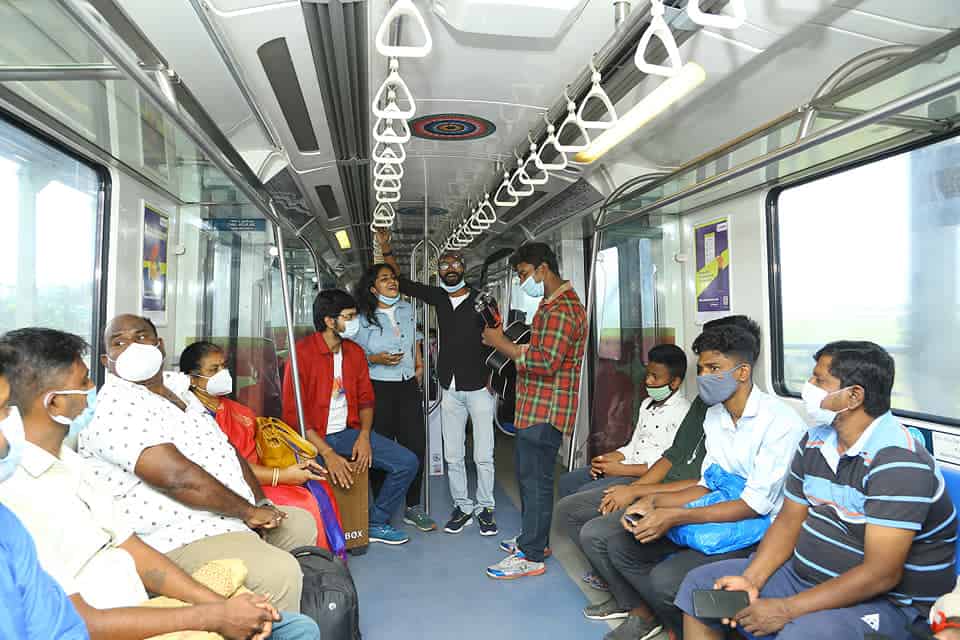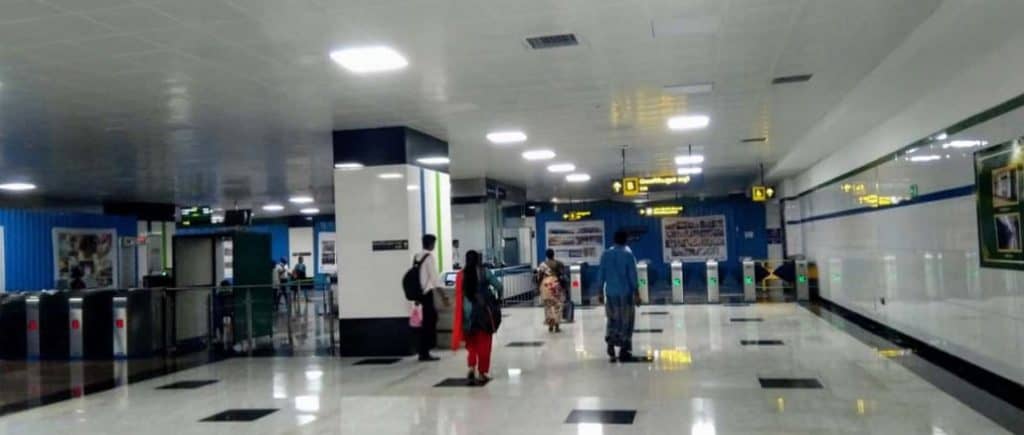According to reports in media, the average footfall on Chennai Metro Rail crossed the one lakh mark in December 2021 and on December 30th, as commuters in the city found road traffic coming to a standstill in the face of unseasonal torrential rain, 1.83 lakh passengers used the Metro on the single day to reach their destinations. While the figures may have made news, it’s clearly not enough to put authorities at ease. For, according to a report by the International Association of Public Transport (UITP), if the Chennai Metro Rail Ltd were to break even, it would have to increase its patronage by 334 percent, which is over 5 lakh commuters per day!
The UITP in November 2021 published a report titled, “Performance of Indian Metro Systems: Lessons for Upcoming Urban Rail Projects”, presenting the operational and financial performance of the metro rail systems of four Indian cities – Delhi, Mumbai, Bengaluru and Chennai, which are the cities with the longest approved metro network in the country. According to the report, during the financial year 2019-20, Chennai Metro Rail Ltd (CMRL) is said to have incurred a total annual loss of Rs 525 crore.
The study which used the urban rail systems in London, Singapore and Hong Kong as benchmarks for the performance review, found that the metro rail of other three Indian cities, along with Chennai, have also incurred losses during the same period.
Read more: Chennai Metro has failed to boost the city’s economy; here’s why
Performance indicators
However, it was not just the financial performance that was analysed in the UITP knowledge brief. To understand the financial state of the urban rail system, it is necessary to also get an idea about the operational performance of the transport authority.
Chennai metro, with a total network length of 45 kms currently, is on the path of expansion. Its second phase covering a total 118.9 kms is expected to be ready by the year 2025. According to reports, the CMRL, in October last year had floated tenders to procure tracks, telecommunication and other systems required for efficient monitoring and operation of metro trains.
The various indicators that were used for the purpose of analysing the operational performance of the metro systems are:
- Daily ridership and ridership per km network
As per the report, Chennai metro, during the financial year 2019-20, recorded an average daily ridership of 0.1 million, with the ridership per km on a single day at 2,553, which is the lowest among the other three Indian metros.
Bengaluru had an average daily ridership of 0.4 million with ridership per km being 9,456, while Mumbai and Delhi recorded a daily ridership of 0.5 million and 5.7 million respectively.

- Comparison between the actual ridership achieved and the initial projected ridership
As of 2020, the Chennai Metro with a total network length of 45 kilometers had only managed to achieve 13% of their projected daily ridership of 0.9 million commuters, while Bengaluru Metro, with a total network length of 42 kilometres managed to achieve 27% of the projected daily ridership of 1.5 million commuters.
In comparison, Mumbai and Delhi managed to achieve 74% and 79% of the proposed daily ridership.
Revenue analysis for Chennai Metro
The indicators that were used to analyse the financial performance of the Metro systems include the total project cost of the metro projects, cost per kilometer of network and the revenue generated.
As far as revenue distribution is concerned, the UITP report states that except for Chennai, the revenue of other Indian metro systems was dominated by operational revenue, which consist of both revenue from passenger tickets (farebox revenue) and revenue from station advertisements, rentals, and so on (non-farebox revenue).

While the metro systems of Delhi, Mumbai and Bengaluru earned more than 80% of their revenue through operational revenue, Chennai earned only 58% from the same – with 42% coming from farebox revenue and 16% from non-farebox revenue through activities like feeder services and property development income.
Non-operational or ‘other revenue’ includes deferred income such as monetary grants towards capital expenditure, revenue from sale of scraps, interest income from deposits and advances, sale of tender documents among others.
Read more: Chennai Metro’s Kathipara urban square project: What citizens can look forward to
“Low operational revenue proportion can be attributed to the high share of grants received from the Government of India and Government of Tamil Nadu, worth 26% of the total revenue,” says the report.
According to the report, Chennai metro made Rs 287 crore as total revenue during the financial year 2019-20 and also had total expenses of Rs 812 crore resulting in a total loss of Rs 525 crore during the period. The report states that CMRL has to increase its patronage by 334% to break even, and if it is to achieve its proposed ridership, it has to increase its patronage by 685%.
Recommendations moving forward
While CMRL has its task cut out in terms of increase in patronage as well as revenue, experts in the field of mobility feel that in order to achieve that, the urban rail authority must look at making changes at various levels, right from the cost of tickets to increasing more feeder services.
K P Subramanian, former professor of Urban Engineering at Anna University, feels that CMRL should first think of reducing the minimum ticket fare. “It should be decreased to Rs 5, on par with that of Kolkata, in which case, the patronage could see a quantum jump and lead to a reduction in revenue loss,” says Subramanian.
The former professor also feels that a unified transport authority in the city like the Chennai Unified Metropolitan Transport Authority (CUMTA) would also play a crucial role in integrating the metro with other modes of public transport, which would serve the purpose of first and last mile connectivity.
1. Align the fare to equal to Chennai MTC’s ordinary or delux bus fare, you can see an automatic increase in foot fall. Once the footfall increases, ad revenue also would increase.
2. Accelarate completion of MRTS rail upto st thomas mount station. All legal hurdles have been cleared for the last 500 meters, which had been pending for over 15 years. This would make st thomas mount a multi modal transit hub.A sizeable crowd commuting from Koyamedu to Velacheri or Thiruvanmiyur would switch to Metro and MRTS, as it would be very quick.
To travel from Airport to Central, commuters have other facilities like local Raiway trains and buses. So passengers will obviously will take the facility that they would pay less.
Simple, Chennai metro is not where the IT sector is. Expanding it in south Chennai will see these numbers go up substantially.
I think the staff should allow people to buy tickets over the counter,rather than forcing them to use vending machines. You can’t expect everyone to use them.
Sorry Korah Abraham, but the UITP report used “line utilization” for delhi metro while quoting 5.7 million ridership a day. Thus, the comparison, analysis & deductions arrived at in the report do not present an accurate picture.
Line utilization counts the same passenger multiple times if he used more than one line during the same trip. The actual daily ridership for delhi metro was 27.11 lakhs per day & not 57 lakhs during 2019-20. See the CAG report link below for more details.
https://cag.gov.in/en/audit-report/details/114644
I think one of the objects of metro rail project is to reduce pollution load (from the transport sector) by attracting personalised modes namely cars and two wheelers. This object cannot be met by attracting passengers from other public transport systems like bus. That is why they pitched fares little higher than the city bus system.They can review that as suggested by Prof. Dr. KPS. CMRL failed on two counts. One, in their stations either there is poor park & ride facility or there is no such facility at all.Second CMRL is poor in planning last mile connectivity issues.If they apply their mind in a pragmative manner they can perform better.
Last mile connectivity is a very relevant issue, which has to be practically approached having the convenience of thr commuter as the goal. Patronage will increase will be phenomenal.